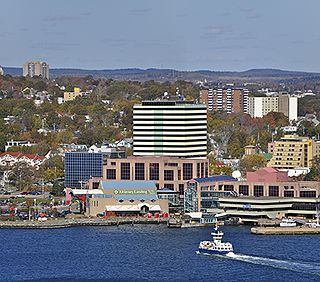
Dartmouth is a built-up community of Halifax Regional Municipality, Nova Scotia, Canada. Located on the eastern shore of Halifax Harbour, Dartmouth has 72,139 residents as of 2021.

Husky Energy Inc. was a Canadian company engaged in hydrocarbon exploration, headquartered in Calgary, Alberta, Canada. It operates in Western and Atlantic Canada, the United States and the Asia Pacific region, with upstream and downstream business segments. In the 2020 Forbes Global 2000, Husky Energy was ranked as the 1443rd-largest public company in the world.

Dartmouth—Cole Harbour is a federal electoral district in Nova Scotia, Canada, that has been represented in the House of Commons of Canada since 2004.

Halifax is the capital and largest municipality of the Canadian province of Nova Scotia, and the largest municipality in Atlantic Canada. Halifax is one of Canada's fastest growing municipalities, and as of 2022, it is estimated that the CMA population of Halifax was 480,582, with 348,634 people in its urban area. The regional municipality consists of four former municipalities that were amalgamated in 1996: Halifax, Dartmouth, Bedford, and Halifax County.
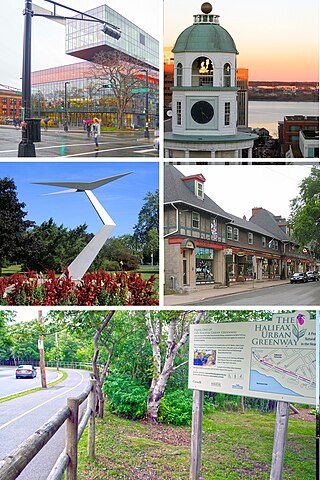
The Halifax Peninsula is a peninsula within the urban area of the Municipality of Halifax, Nova Scotia.

Eastern Passage is an unincorporated suburban community in Halifax Regional Municipality Nova Scotia, Canada.
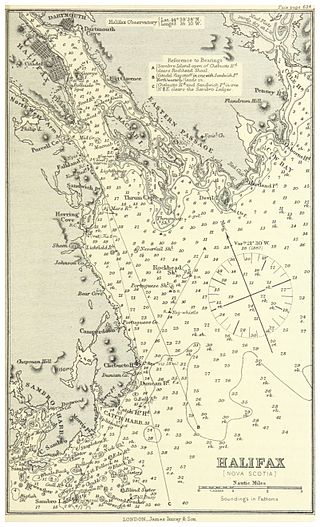
Halifax Harbour is a large natural harbour on the Atlantic coast of Nova Scotia, Canada, located in the Halifax Regional Municipality. Halifax largely owes its existence to the harbour, being one of the largest and deepest ice-free natural harbours in the world. Before Confederation it was one of the most important commercial ports on the Atlantic seaboard. In 1917, it was the site of the world's largest man-made accidental explosion, when the SS Mont-Blanc blew up in the Halifax Explosion of December 6.
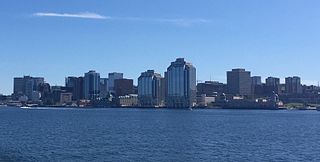
Downtown Halifax is the primary central business district of the Municipality of Halifax. Located on the central-eastern portion of the Halifax Peninsula, on Halifax Harbour. Along with Downtown Dartmouth, and other de facto central business districts within the Municipality, Downtown Halifax serves as the business, entertainment, and tourism hub of the region.
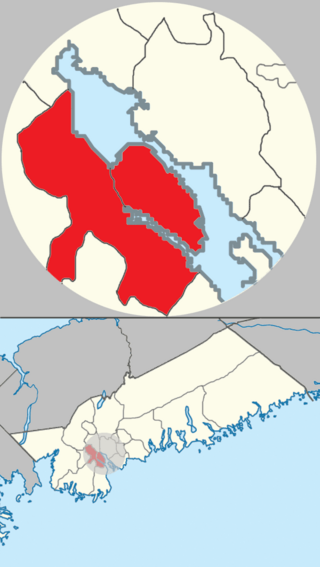
The community of Halifax, Nova Scotia was created on 1 April 1996, when the City of Dartmouth, the City of Halifax, the Town of Bedford, and the County of Halifax amalgamated and formed the Halifax Regional Municipality. The former City of Halifax was dissolved, and transformed into the Community of Halifax within the municipality.
The Nanticoke Refinery is an oil refinery in Nanticoke, Ontario, Canada. It is owned and operated by Imperial Oil, which is majority owned by ExxonMobil. The refuels primarily go to Esso-branded gas stations in Canada and to other oil companies' distribution networks in Canada and the United States.

Woodside is an unincorporated middle income urban locality of Dartmouth, within the Halifax Regional Municipality, Nova Scotia. The community is divided into North Woodside and South Woodside. Woodside is home to two hospitals: the Dartmouth General Hospital and the Nova Scotia Hospital.
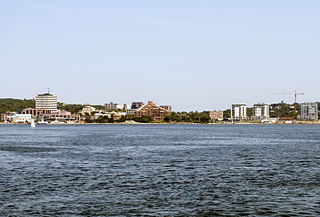
Downtown Dartmouth is the main central business district of Dartmouth in Halifax, Nova Scotia, Canada. It is part of the Capital District of the Province.

The Dartmouth Refinery is a former oil refinery in Dartmouth, Nova Scotia, owned by Imperial Oil. It was located on the eastern side of Halifax Harbour, and the crude oil arrived via ship. It covered some 400 hectares south of central Dartmouth, with the neighbourhood around it being known as Imperoyal.
The Halifax Regional Municipality (HRM) is a major generator of economic activity in Atlantic Canada.

East Tilbury is a village and former civil parish in the unitary authority of Thurrock borough, Essex, England, and one of the traditional Church of England parishes in Thurrock. In 2011 the ward had a population of 6,363.

Alberta's Industrial Heartland is the largest industrial area in Western Canada and a joint land-use planning and development initiative between five municipalities in the Edmonton Capital Region to attract investment in the chemical, petrochemical, oil, and gas industries to the region. It is "home to more than 40 petrochemical companies" and is one of Canada's largest petrochemical processing regions." By July 2015 there was $13 billion invested in new industrial projects providing employment for 25,000 in the Alberta's Industrial Heartland.

Boynton and Oakwood Heights are the two southernmost neighborhoods of the city of Detroit in the U.S. state of Michigan. The two neighborhoods occupy the only portions of Detroit located south of the River Rouge.

Fort Clarence was a British coastal fort built in 1754 at the beginning of the French and Indian War in Dartmouth, Nova Scotia, Canada. The battery was built on the grant of Capt. John Rous. Initially it had 8 guns mounted. In spring 1759, a Mi'kmaq attack on the Eastern Battery killed five soldiers.


















